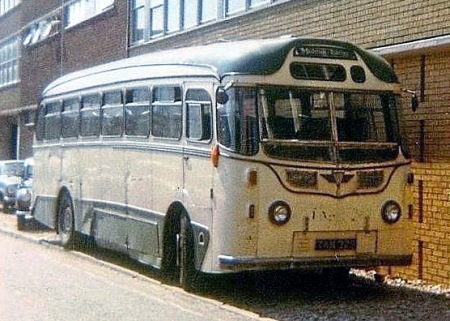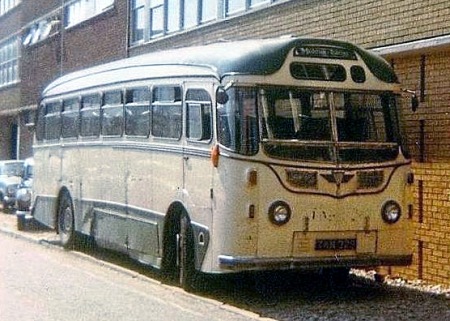Maidstone & District Motor Services Ltd
1954
AEC Reliance MU3RV
Harrington C37C
A recent posting led to a discussion about the relative importance in a PSV of economy, reliability and good looks, and I picked this vehicle as an example that in my opinion embraces all three qualities. Beauty is in the eye of the beholder and my personal preferences may not be shared by others, but the lines of these coaches always seemed to me to be well-balanced and elegant in an understated way, if, perhaps, a trifle old-fashioned. The styling of the roofline around the destination indicator was a treatment popular with many coach builders and operators for front-engined vehicles, but by the mid-1950s, the effect had become a bit dated. Very appealing, nevertheless, and the epitome of high quality and pedigree.
Sadly, C329 doesn’t look its best in the photo – absolutely no criticism of Chris’s camera work, but following withdrawal it’s become scruffy and the sun’s angle casts a shadow that exaggerates the front windscreen divisions. Also, the “moustache” beading may seem fussy, but it was almost an M&D trademark. I’d be grateful for other correspondents’ views on C329’s attractiveness or otherwise.
[This link will show C328, in rather smarter condition.]
M&D were substantial Harrington customers for many years and they had almost 50 vehicles of this design in their extensive, (I’d say excessive), coach fleet. By the time I joined, they had been withdrawn from front line express duties, however, and were kept mainly to provide summer capacity. Like every underfloor-engined AEC I ever drove, their road manners were impeccable. Even the prospect of a spell at the wheel was a pleasure to look forward to. They were also both economical and very reliable.
Inside, these coaches were not, perhaps, as light and airy as some of their contemporaries, but there was no sense of claustrophobia. On the contrary, they conveyed an atmosphere of relaxation, reinforced by the wonderfully comfortable seats and by their extraordinary quietness. Their main drawback, (only drawback as far as I’m concerned), was the centre entrance, which made it uneconomic to convert them to other uses.
Photo by Chris Hough. Many thanks for his kind permission to use it.
Copy contributed by Roy Burke
A full list of Reliance codes can be seen here.
17/08/12 – 07:22
6 of this batch were acquired by Yorkshire Woollen where they were nicknamed Gunboats by the crews.TKM 304/26/347/348/9/5O were numbered 435-440. They were purchased to replace a similar number of Commer/Beadles. Another member of the batch was purchased by Hebble Motor Services at Halifax to replace an ex Red Line Reliance that was a fire victim. After YWD they went on to an operator called Davies of Ferryhill County Durham except for 436 that was broken up by YWD after a bad accident.
Philip Carlton
17/08/12 – 07:23
As a northern boy I didn’t get to see the inside. My personal view of the outside is of a fine looking coach. Perhaps one-too-many windows/panels. One less, but slightly longer would have enhanced the appearance, and the roofline over the front is not enhanced by the application of the livery. In my opinion the cream area should have followed the outline of the roof – then- almost perfection. No doubt others will say tosh, but that’s my thought.
Les Dickinson
17/08/12 – 10:26
The box for the fleetname over the destination and service number boxes doesn’t help the outline. Either omit the fleetname or omit the service number box and have the destination and fleetname side by side. Then use another BET operator’s style of livery (Ribble or Southdown) and it would make quite a lot of difference. As we are, it seems a feeble attempt at imitating the Silver Star front dome.
Pete Davies
17/08/12 – 12:32
As a Kentishman I have to say I can’t see anything wrong with the livery or layout of the destination!
Shame to see this looking so scruffy though – I remember these coaches featuring on the cover of M&D’s tours brochures which were captioned “Over the hills and far away”.
The Silver Star “headboard” was an abomination on this design and ruined an otherwise graceful look.
All these things are of course subjective…
Andrew Goodwin
17/08/12 – 12:33
Roy is right about the state of the coach and very kind about my photograph! The coach was parked in a back street in Preston and was certainly not in the M&D fleet! Like a number of fifties coaches these seem to be built like the proverbial brick Outhouse!
Chris Hough
17/08/12 – 16:29
I have to disagree with Andrew on this one – I thought that the Silver Star Wayfarer Mark 2s were vastly improved by their headboards, unlike that operator’s all-Leyland Royal Tigers and Burlingham Seagull which really did look atrocious. Preservationists seem to agree with me as both MMR 552 and 553 are still with us, and the owner of “553” once told me that there was a waiting list of people who wanted to buy the coach from him at any reasonable price. If I ever win the jackpot in the lottery I will outbid them all!
Neville Mercer
There is a posting of them both together coming shortly. Watch this space as they say.
Peter
18/08/12 – 07:40
In my opinion, which doesn’t count for much…I think that destination information on the front of bus/coaches should always be upright so that reflections are reduced and they become easier for those of us whose sight is not 20/20 to read at a glance. Obviously that would not tie in very well with the design of this coach, but I must admit that the picture of it in the link is very smart and clean…
Norman Long
20/08/12 – 08:05
Funny: until this very moment I’ve looked at photographs of these vehicles and thought “M&D coach, nice”: but all of a sudden the affinity with some nasty little Gurney-Nutting(?) bodied Commers(?) has struck me, and now I just find them hideous. Why? The “pinched-in front”, the way the front dome just seems to push the already squeezed-in front down, giving a sort of hump-backed appearance to the whole thing – and there are too many windows, which (on their own) I could live with. Ugh. In full M&D rig and in the context of when they were built it might have been a different story . . .
Philip Rushworth
20/08/12 – 09:08
Philip, nice to see there are people who can call “the Emperor’s new clothes” in the face of popular opinion.
M & D vehicles were just magnificently turned out, but I never rated these Harringtons. They got it very right with the Cavalier/Grenadier but the Bedford/Ford versions were hideous and the Legionnaire not much better. Balanced design again – you either have or you don’t.
David Oldfield
20/08/12 – 14:02
I’ve held back until now on commenting about these Harrington bodies, but seeing that Philip Rushworth and David Oldfield have entered less than rhapsodic views about them, I will say that I always thought them to be incredibly ugly vehicles. Just compare the styling with other contemporary designs using curved corner glasses at the front – the classic ECW LS coach, for example. Harrington did very much better with the Cavalier.
Roger Cox
24/08/12 – 08:36
Who’d build coach bodies – it’s a fickle market isn’t it? driven by fashion, rather than by loyalty. Burlingham got it right with the “original” Seagull then missed the “zeitgeist” with subsequent offerings; as did Harrington with the Cavalier/Grenadier; Duple seemed to judge the market right for many years until gradually loosing the plot and fading away in the 80s(?); and Plaxton seems have picked up from the mid-1960s with the introduction of the Panorama. However, history seems to suggest the Plaxton’s days are numbered, and that they are due to misjudge the market and enter decline (look what happened to Leyland et. al.) . . . but there aren’t any more British coach builders to take their place!
Philip Rushworth
24/08/12 – 12:24
You’re so right Philip. Duple lost the plot and went bust at the end of the ’80s – when Plaxton bought their intellectual rights. Duple’s is a very sad story inexorably linked with a certain Mr Ford who had previously fallen out with Plaxton and moved over to Duple – hence the vague similarity between the Panorama Elite and the Dominant.
David Oldfield
24/08/12 – 12:25
Seems I’m in a small minority in liking this design. At the risk of losing whatever tiny credibility I might ever have had in these pages, however, I remain unrepentant.
Roy Burke
24/08/12 – 15:43
You’re still welcome and entirely entitled to your own opinions, Roy. There are times when – in my professional, musical life – I differ from my colleagues. Grown ups accept each other, regardless (and I think most of us are grown up on this forum).
David Oldfield
11/02/13 – 13:27
You’re not alone Roy, I like the Wayfarer 2 style as well. I don’t think it was as nice as the later Wayfarer 4 but for an early 1950s body, I think it was quite stylish. It did make an attempt to get away from just being a box, which is so easy on an underfloor flat front single decker. I think Harrington bodies were all of real quality and generally well styled (with as always the obligatory exception). They were certainly better looking than many of the competitors’ efforts.
Gordon Mackley
14/06/13 – 07:31
The Reliance Harrington C37C don’t remember them even though grew up with M & D but can say I was on one just last week don’t remember batch but sure worked all over the M & D patch ended its days think in Bexhill can say a very impressive coach so as they say watch this space soon be out of hiding.
Paul
 Vehicle reminder shot for this posting
Vehicle reminder shot for this posting
08/06/15 – 16:08
Maidstone and District’s Wayfarer 2 bodies came on three different types of chassis and they were each very different. The most numerous (in terms of both vehicles and photos) were the AEC Reliances. The Leyland Royal Tiger versions had central entrances like the AECs and might have been expected to be the same but in fact had vertical rather than sloping window pillars. The Commer Contender versions were of a completely different configuration, having front entrances. Interestingly the centre entrance coaches had front offside emergency exits and the front entrance Contenders centre ones!
Gordon Mackley

Leave a Reply